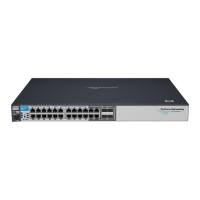3. When restoring a primary node, re-enter the IP addresses of the secondary nodes. See Setting
the Network Settings using Command View VLS.
4. At this point the warm failover process automatically restores the node to its previous configuration
including the serial numbers, front-end Fibre Channel WWPNs, virtual device configuration, and
licenses. No reconfiguration is required. See Warm Failover.
Restoring a VLS running firmware version 2.x or 3.1:
1. When restoring a primary node, power up the secondary nodes once the primary node fully
reboots.
2. When restoring a primary node, add the secondary nodes through Command View VLS. See
Configuring the Secondary Nodes 1 through 7.
3. Restore the configuration settings. See Restoring the Configuration Settings.
4. If one or more capacity and/or deduplication licenses had been added to the VLS, re-install the
VLS capacity and deduplication licenses. See Re-installing the VLS Licenses.
The node is now fully restored.
Restoring the Configuration Settings
The VLS virtual library configuration and network settings can be quickly restored from the configuration
file created by performing Saving Configuration Settings. See Restoring the Virtual Library Configuration
from a Configuration File.
If a configuration file was not created, you must reconfigure the network settings, and rebuild the
virtual library and virtual drive configurations, and the VLS Gateway storage pool configurations (see
Recreating VLS12000 Gateway Storage Pools). The cartridge configurations, however, do not have
to be rebuilt, as they are stored on the disk arrays. See Rebuilding the Virtual Library Configuration.
Restoring the Virtual Library Configuration from a Configuration File
Restoring the virtual library configuration from the configuration file restores the virtual library and
virtual drive configurations, and administrative and network settings (including the VLS serial number
and persistent Fibre Channel port WWPNs).
NOTE:
Configuration files are not backwards compatible with earlier firmware versions. For example, a
configuration file created on a system running firmware version 3.1.2 will not work on the system at
firmware version 3.1.0. Make sure your system is at the version that created the configuration file
before restoring the configuration.
To restore the virtual library and network settings from the configuration file:
1. Set the network settings so you can open a Command View VLS session. See Setting the Network
Settings.
Disaster Recovery210

